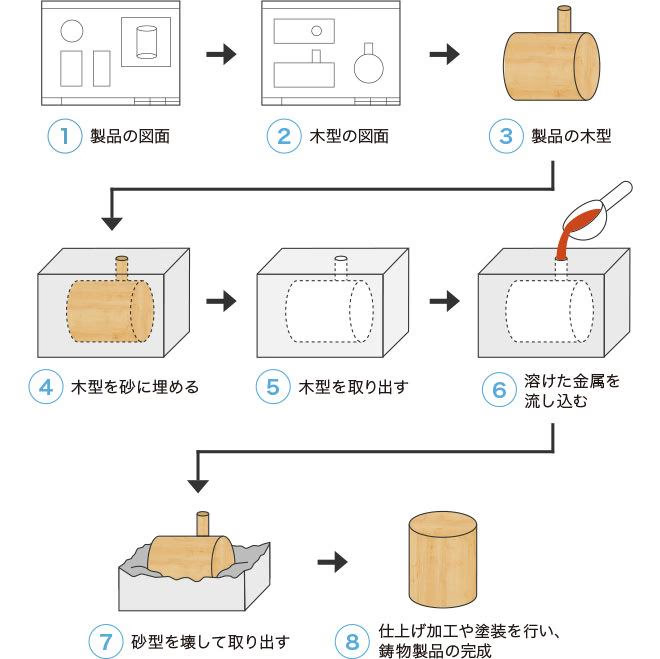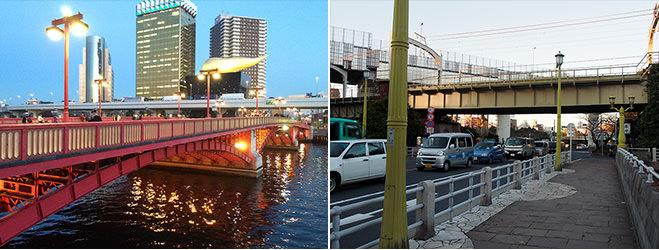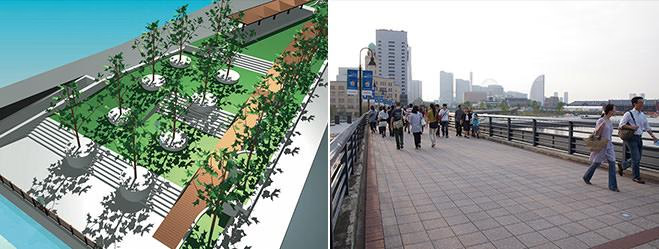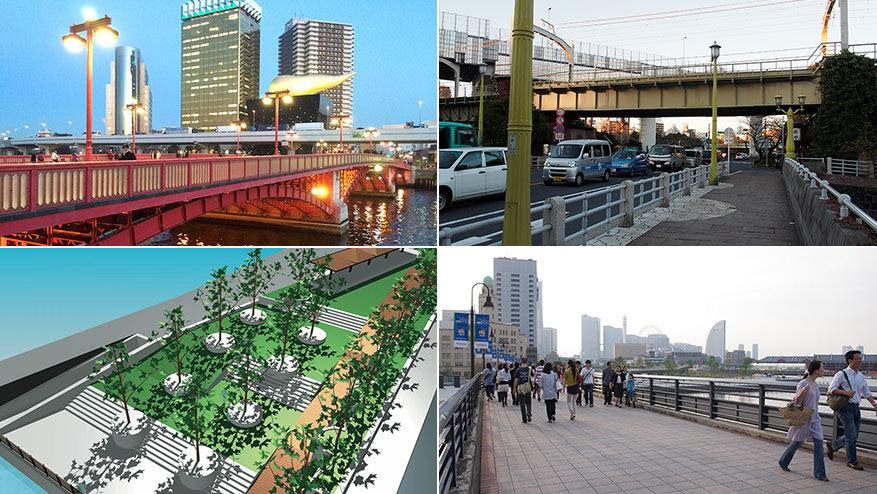こんにちは、プロデュース部の上井です。
主に、システム開発や連携をともなうようなサイト構築で、プロジェクトマネージャー(以下:プロマネ)を担当しています。
これまでは、鉄の鋳物メーカーでのエクステリアデザイナー、建設コンサルタント、SIer、広告制作会社を経て、モノサスでWeb制作・開発のプロマネ担当していますが、どんな業態でも「上流工程(設計)が品質を左右する」というのは共通だと感じてきました。
そんな経験を経て、ものづくりにおいて心がけているのは、
源流主義:品質は、設計で作り込む。
ということ。
今回は、そう考えるにいたった理由を、私の体験を交えてお伝えしたいと思います。
源流主義の発端は、エクステリア・デザインの世界から
社会人スタート時、私は鋳物メーカーにて、橋の欄干、駅前広場や遊歩道、公園などの公共施設に設置されるエクステリア製品のデザイン・設計に携わっていました。
例えば橋の欄干は、数百メートルに渡って数百もの製品が連続して設置されるものなので、オリジナルに設計されるものでも、チョットした量産です。
また、金属製品は加工も難しく、重量も数十kgから数百kgとなるため、運搬・設置にも、多くの人手と機材が必要となりますので、仕上がりに不満点や不具合があっても、持ち帰ってチョット直す、というわけにはいかないのです。
そのためメーカーには、独立した品質管理部門を設けていることが一般的です。
エクステリア製品の品質管理で最も重視されるのは、強度と安全性です。利用者の安全を確保することが第一義としてあるからです。
そして、最も優先順位が低くなるのが、デザインのディテールだったりします。
これを何とかしたい、という思いが設計に対する姿勢となり、今に続いています。
設計図をとおし、後ろの工程に意図を伝える経験
ここで少し、鋳物の製造工程をご紹介いたします。
鋳物の製品を作るには、2種類の型を準備します。
1つめは、金属を流し込む雌型である「砂型」。
2つめが、この砂型を作るための雄型である「木型」です。
この、木型を設計するために使用されるモノサシが「鋳物尺」です。
砂型の中の空洞に、溶かした金属を流し込んで形づくる製造方法を「砂型鋳造」と言います。

図:砂型鋳造の製造方法
砂型に流し込まれた溶けた金属は、冷えて固まると体積が縮みます。
なので砂型の空洞の型となる木型の図面は、金属の収縮率に合わせて、完成形の長さよりも目盛を大きくふったモノサシ(=鋳物尺)で作成する必要があります。
そのため、出来上がる製品のディテールの処理や収め方が、デザインで意図したものと違うことが多々ありました。
橋や遊歩道は、デザインや計画から1年近く経ってから施工されることも一般的です。また製造のタイミングによっては、木型の設計・製作は地方の木型屋に依頼されることもあります。そのため、木型の製作図をデザイナーがチェックできる機会はほとんどありません。
鋳物の製品が出来上がってきて初めてディテール処理がイメージと違うと、残念に思うことも多かったのです。
そこで、どうするか?
ディテール処理に関する詳細な図面を、自ら作成するようにしました。
橋の欄干の場合、橋の上への設置工事のための施工用図面と、製品を作るための製作用図面を、設計部門が作成します。
この製作用図面は、設置場所ごとのサイズの違いを全て図面化するのですが、仕上がりのディテールは標準サイズの部材の詳細図で指定します。
設計部門にお願いして、この標準サイズの部材の図面作成を担当させてもらったのです。
ただ、製造の難易度が上がりすぎたり、手間が増えると、工期が延び、製造コストに影響を与えます。設計の先輩や工場の大先輩に知恵を絞ってもらったり、やり過ぎを諭されたりを繰り返し、図面に反映していきました。
設計図をとおして後ろの工程に意図を伝える。ということを意識するようになったのが、この時期でした。

鋳物の欄干の例:東京都吾妻橋(左)、東京都枕橋(右)
製品の設計から計画の設計へ
その後、地域の再開発における、いち街区の歩道部分全体の、エクステリアデザイン、設計などにも携わるようになっていきます。
また、街区の空間の中で、どこに何を配置するかの計画、設計を手がけるようになっていきます。そして、デザイン、設計から製造、施工までの各工程の専門家や職人の知恵、各メーカーの技術を繋ぎあわせることに、仕事の面白みを感じるようになっていきました。
この思いが嵩じて、社会人10年目に建設コンサルタントに転職、製品の設計から、計画の設計に職域を変えることになりました。

公園計画CGの例(左)、遊歩道の例:横浜市臨港プロムナード(右)
源流主義:品質は設計で作り込む
公共事業は、大まかに以下の4つのステップで進められます。1 〜 3 を建設コンサルタント、4 をゼネコンが実施します。
- 基本計画 :事業概要の策定、比較案の検討、予算規模の計画
- 基本設計 :比較案の設計・検討・案選定、概算工費算出
- 詳細設計(実施設計):工事発注・施工レベルの図面作成、数量算出、工費算出
-
施工 :製造、施工
1. 基本計画 2. 基本設計は、半年〜1年、3. 詳細設計は、1年〜複数年の時間をかけて実施されます。
また、各段階の設計は、異なる会社に発注される場合もあります。
そのため、各設計工程での品質管理は厳密です。上流工程の設計に不備があった場合、下流工程の品質劣化に直結するからです。
在籍した建設コンサルタントでは、ISO 9001による品質マネジメントを実施していました。
ここでの約3年間、さまざまなプロジェクトを経験しましたが、常に意識させられたのは、
「品質は設計で作り込むもの」ということ。上流の工程で品質を作り込むことの重要性(源流主義)でした。
そして、このことは、システム開発やWeb制作においても共通であり、最も重要です。
製造、建築・土木設計の分野では、品質管理に関わる視点、枠組み、取り組みについて、積み重ねられた知識が体系化されており、Web制作にも置き換えられると考えます。これらについては、次の機会に。
